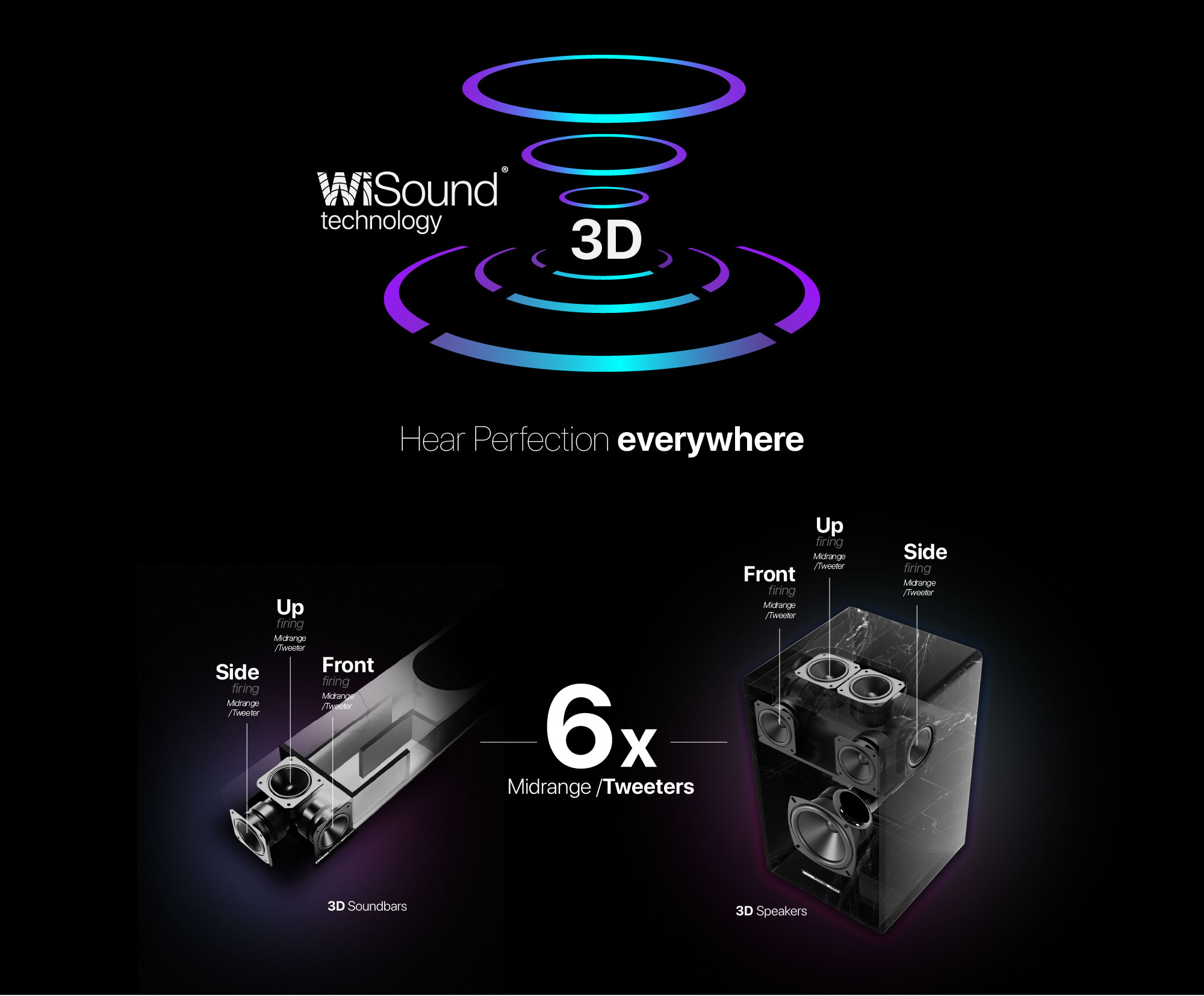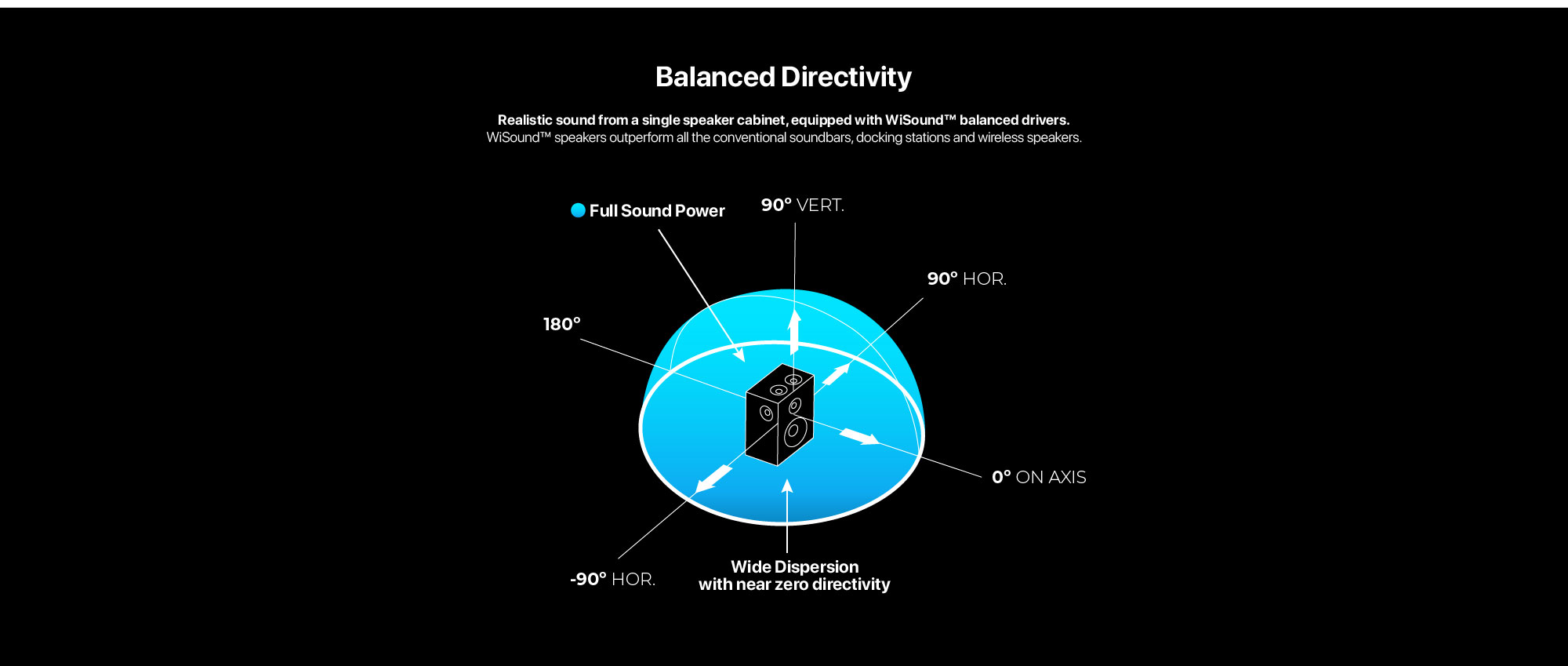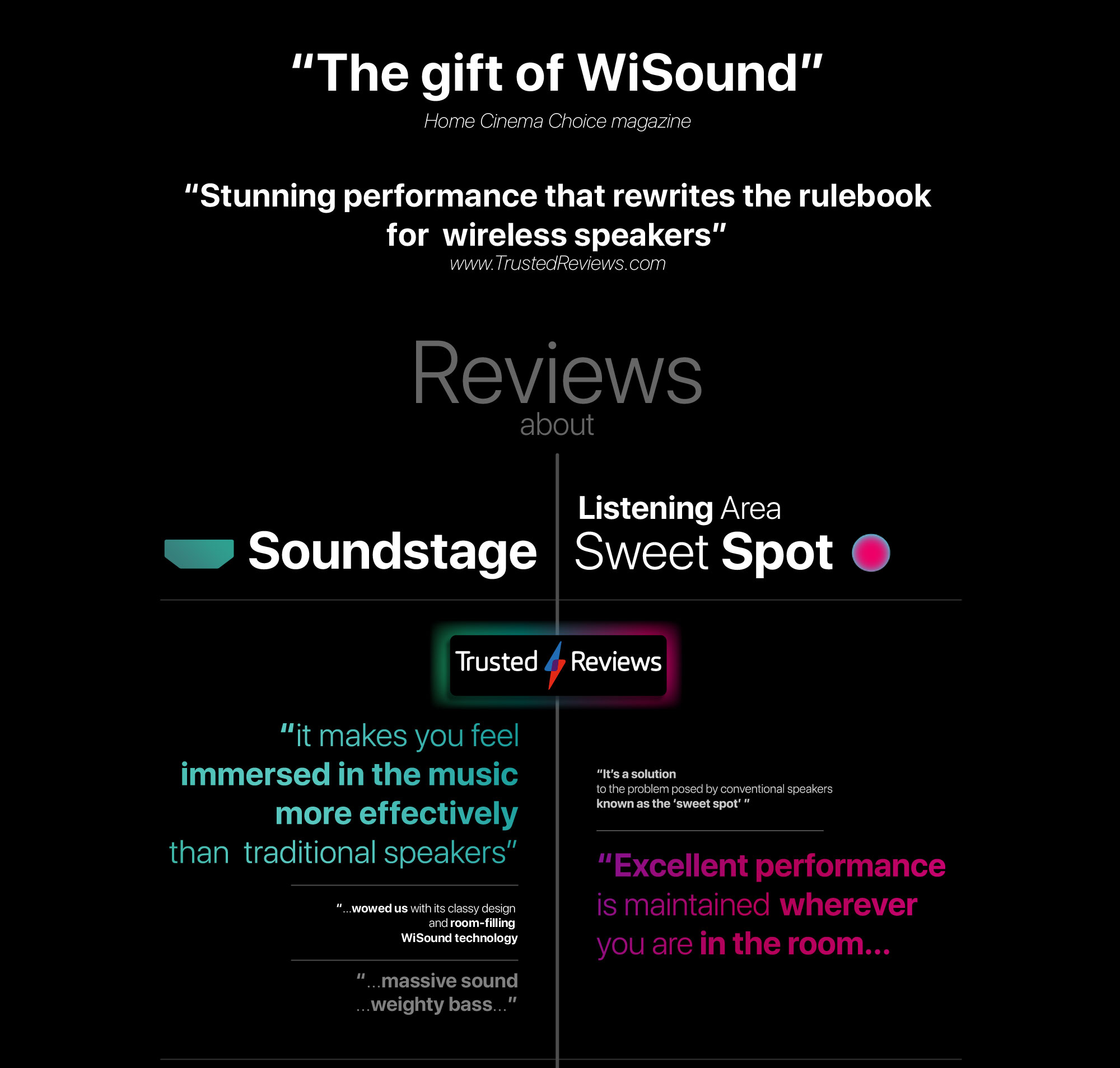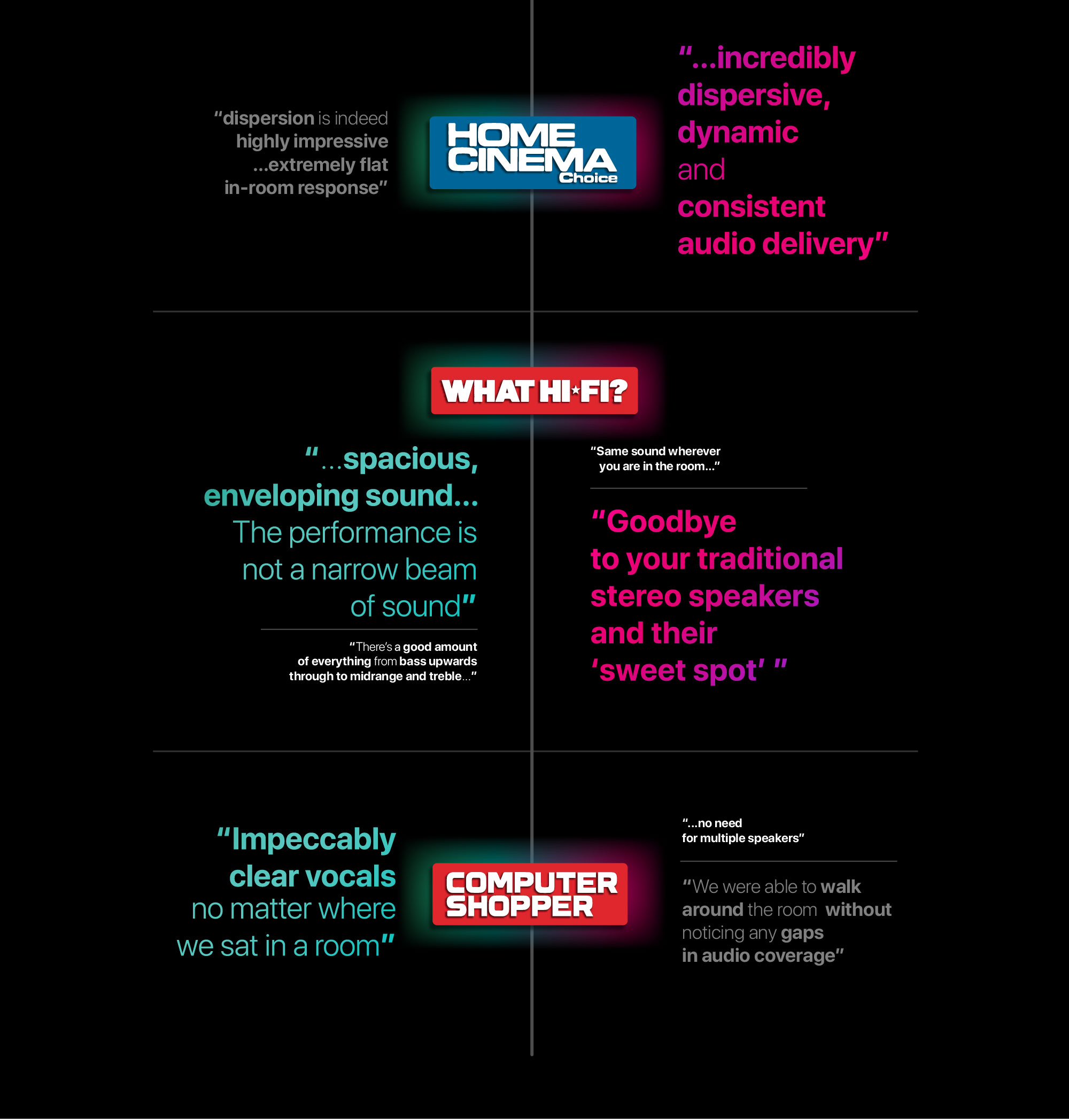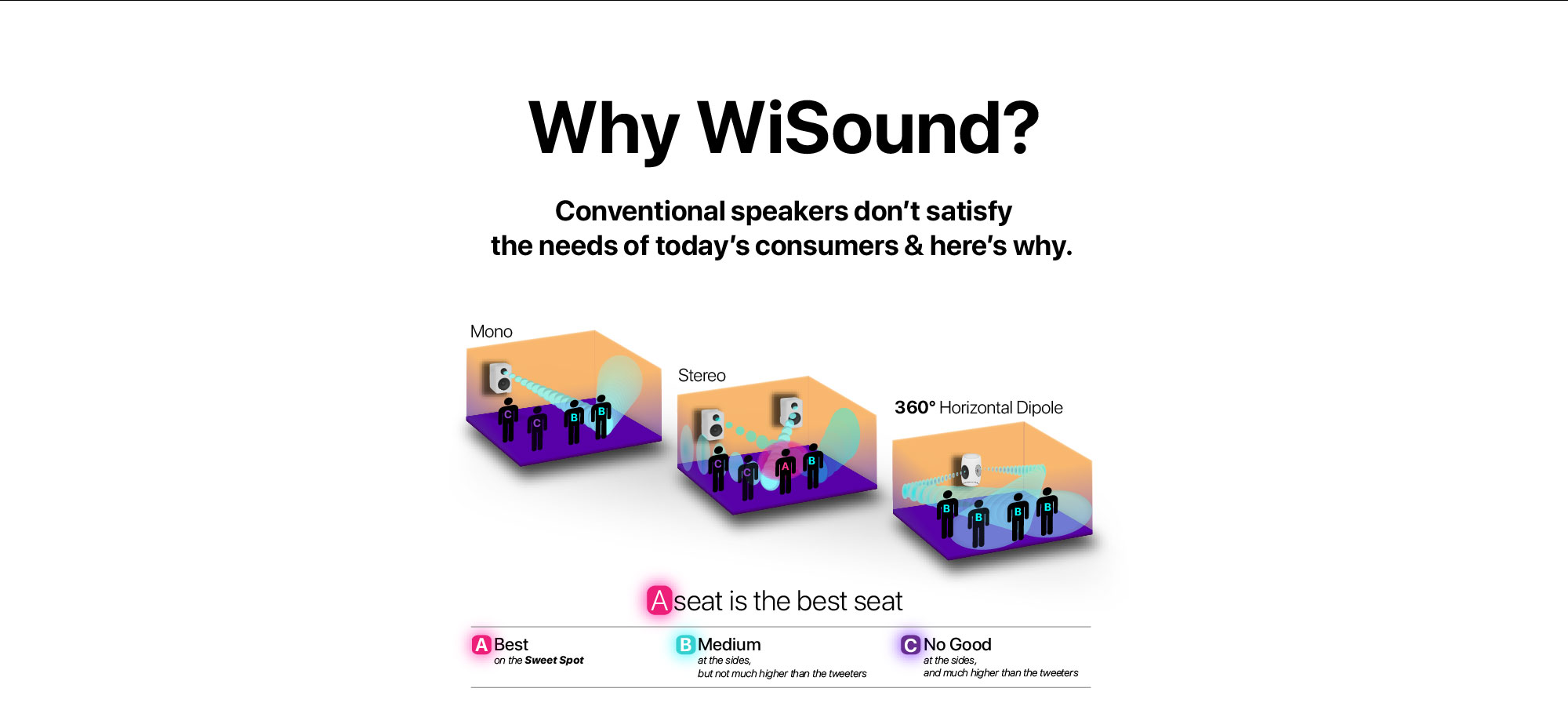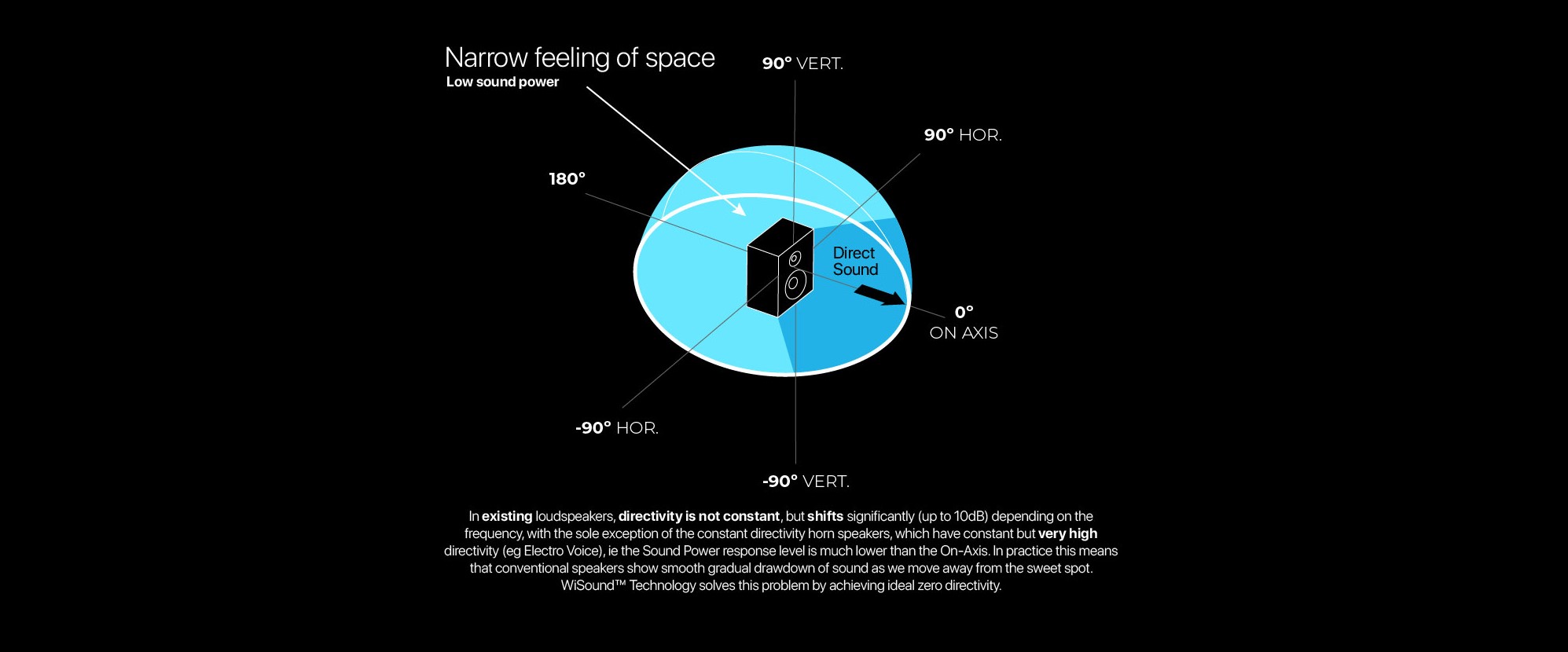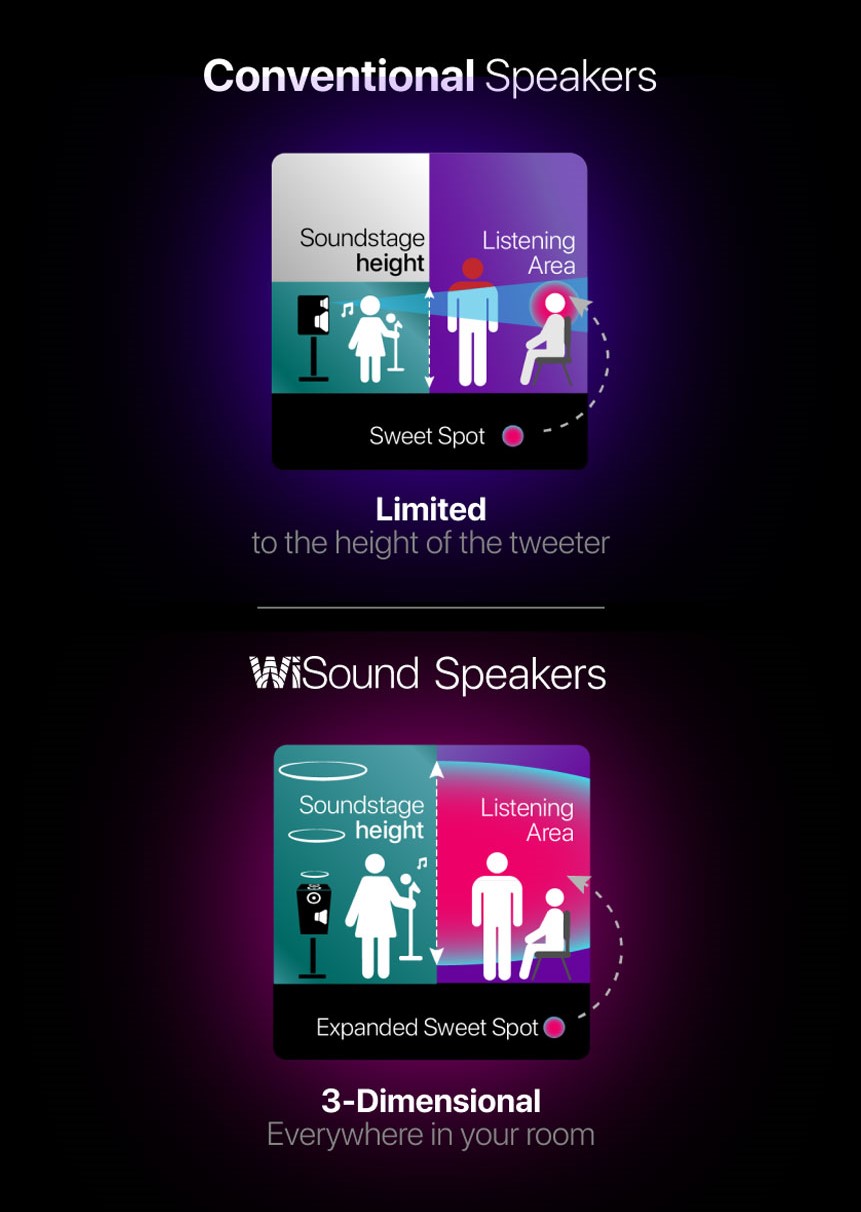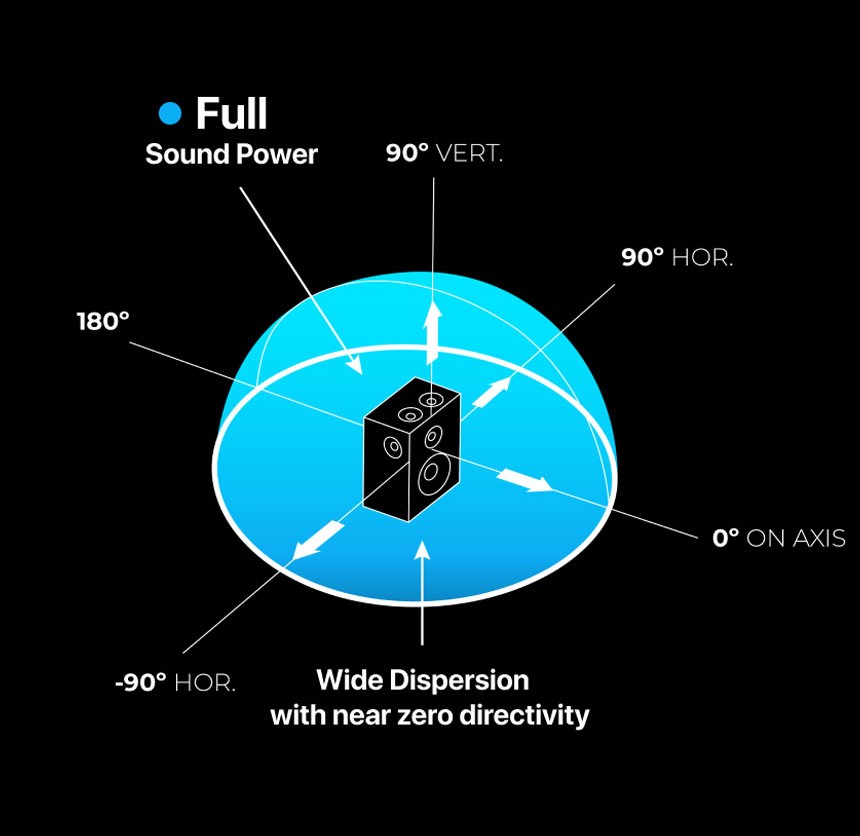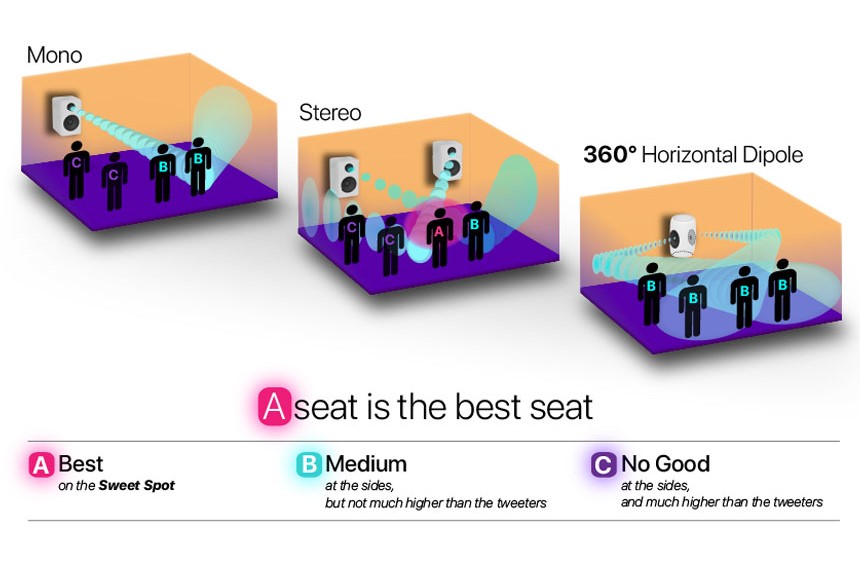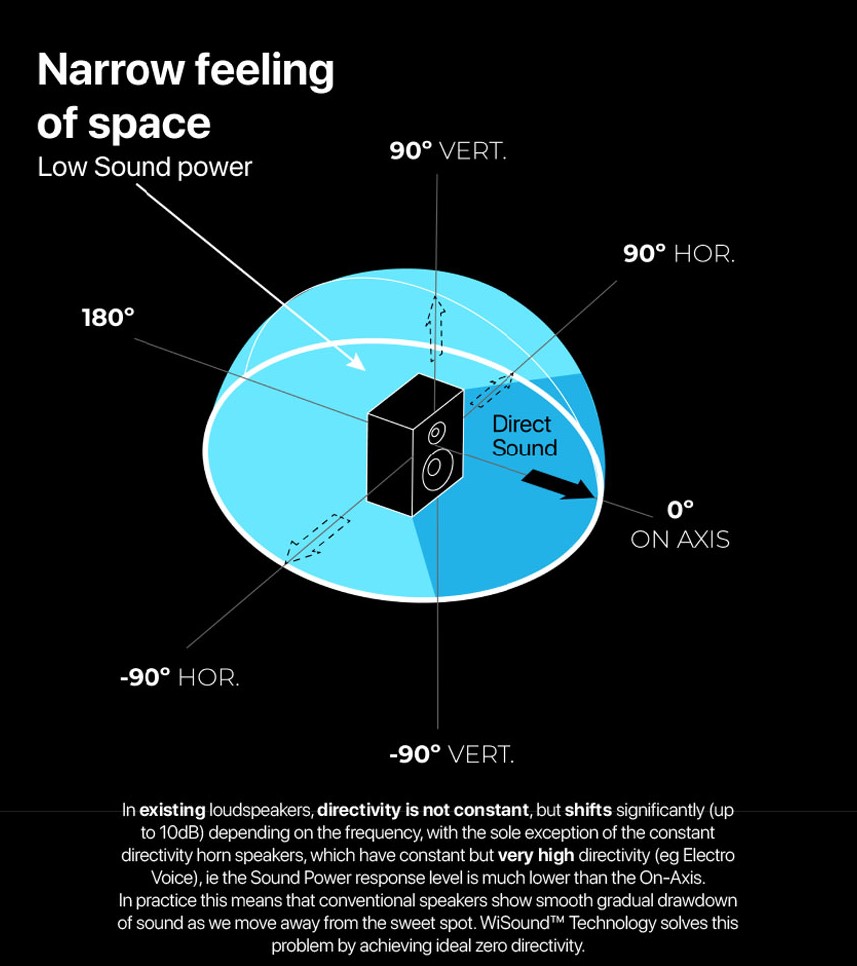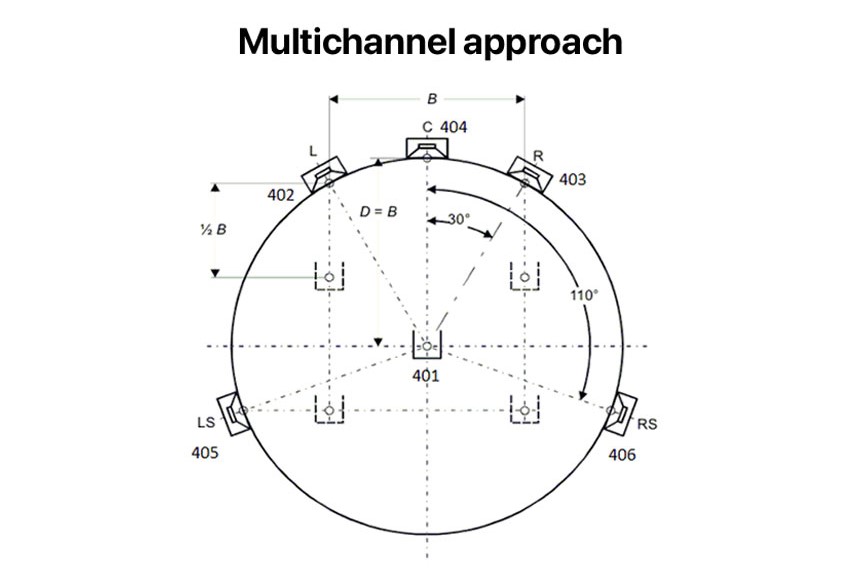New models with leading technology and exciting performance are coming soon!
Balanced
Up, Front, & Side firing drivers
• Balanced 360° Horizontal & Vertical Response
• Balanced Direct & Reflected Sound everywhere in the room
• Balanced Room & Speaker Interaction
WiSound DSP
1. WiSound Acoustic Algorithms
Process a Multitude of Complex
Horizontal & Vertical Measurements 360° around the speaker
for perfect Room & Speaker Integration
2. WiSound DSP Integrates
the WiSound Algorithms
with the Electro-Acoustic System of
Drivers & Electronics
3. WiSound Engineers
Customize WiSound DSP Optimizers
according to the specific parameters of each speaker system
4. WiSound Certified Manufacturers:
• Use WiSound Laboratory Testing & Quality Control
• Create Best Value for Money Products with Certified 3D-Balanced Response
Advantages
1. WiSound balances the sounds throughout the listening area, not just in the on-axis position in front of the speakers.
The Sweet Spot of a tight and specific area with the conventional technology widens almost to the entire listening area, with the instruments outlined in space, simulating live music listening conditions.
2. The feeling of space is natural and pleasant. The listener is released from the listening limitations of a small room, even if close to the speaker.
3. The Soundstage is natural and enjoyable, like in live music.
4. The Estimated In-Room Response is identical to the Direct Sound response, thanks to the zero Directivity Index (DI = 0) of WiSound Balanced Directivity speakers.
Full-Size Soundstage
Feel the orchestra at full size right in front of you in your room
WiSoundTM technology balances the Room Reflections with the Sound Image in front of the listener.
WiSoundTM 3D Speakers balance the total Sound Power with the Direct Sound.
Feeling of Space
WiSoundTM 3D solves the problem of the limited and unnatural feeling of space created by traditional speakers.
Balanced On-axis & Sound Power Response
Prior art to reproduce the "Feeling of Space"
WiSound developed the first technology with
Balanced Sound Directivity simultaneously
Horizontally & Vertically
from a single speaker.
There is a rich history of technological improvements to reproduce the Natural and Pleasant Feeling of Space.
• The Sweet Spot (401), according to the ITU-R, is the apex of an equilateral triangle, with the other two apexes being the two speakers, L (402) and R (403).
• A center speaker (404) was added to solve this problem.
Multichannel audio technology (402 to 406) developed in recent years, combined with digital audio processing, is a more comprehensive effort to solve the non-uniform frequency response in space.
• The specifications of THX, Dolby, and DTS are characteristic examples.
The popular multichannel systems use separate speakers for the horizontal plane and more for the vertical plane.
• However, the directivity problems remain with typical multichannel speakers.
• Even the speakers with Constant Directivity have high Directivity above 5db or even 10db.
• The directivity problems also remain in soundbars with advanced Digital Sound Processing. Even digital space equalization is not possible to achieve the ideal.
• At best, there is more than one sweet Spot (401) (listening positions, where the sound is correctly heard).
Still, the sound is never uniform at all listening positions.
Spherical Response
The most important and unique characteristic of WiSound speakers is the Flat In-Room Response with
Balanced Sound throughout a wide listening area.
WiSound speakers create a perfectly Balanced Response
for Direct & Reflected Sounds.
• Traditional speakers' optimum performance can be perceived only by a listener sitting in a specific place in front of the speaker(s).
• However, today's consumers lead a multi-tasking lifestyle
that demands flexibility, freedom of movement, and
products that can be easily situated to accommodate interior design choices.
Traditional speakers don't fit the bill. So, what would make the ideal speaker?
The ideal speaker must satisfy both:
• Flat In-Room Response in front of the speaker
• Flat In-Room Response all around the speaker.
Only this way will you have a speaker that delivers the same Sound to your ears–wherever you are in the room.
So, the usual technique of placing the drivers for the midrange and high frequencies in the speaker's front does not achieve the ideal speaker.
• Conventional speakers with the drivers for midrange and high frequencies placed in the front can achieve Flat On-Axis or Flat Sound Power Response, but not both simultaneously.
• The high frequencies' Directivity forces Manufacturers to compromise. This failure results in an uneven dispersion of the Sound in space.
Balanced Up- & Side-firing drivers
Natural Spherical Omni-directional Sound with Balanced Vertical and Horizontal response
WiSoundTM speakers are equipped with balanced Up- and Side-firing drivers for mid and high frequencies.
WiSoundTM patented Flat In-Room Speaker Response technology uses balanced driver pairs instead of traditional front firing drivers.
This way, we achieve a flat, smooth response with both Direct Sound AND spherical Reflected Sound in every direction throughout the room.
Thus smooth reflections and natural sound without colorations are formed. This patented design results in Flat In-Room Response, measured according the ANSI/CTA-2034 standard Method of Measurement for In-Home
Loudspeakers.
Vertical 360 degrees radiation is balanced and equal with the horizontal 360 radiated sound power.
Balanced: Direct Sound & Reflected Sound
Balanced Room and Speaker interaction
Inside a room, we listen to two sound fields:
• Direct Sound
• Reflected Sound
A loudspeaker with Flat In-Room Response exhibits a perfectly balanced sound in every room and at any position in the room, while the reflected sound is balanced with the direct sound.
Feeling of space
One other problem that WiSoundTM Technology solves, is the unnatural feeling of space created by the reflected sound speakers. The speaker manufacturers of this type (most prominently Bose), base their technology on the observation that in a typical indoors concert hall, listeners hear 87% of the sound of music from reflections. So, they created speakers, in which the direct On axis sound radiation is much lower than the Sound Power that determines the intensity of the reflected sound.
However, although the effect is impressive when playing a large orchestra, the soundstage does not have the clarity needed, as it enlarges excessively the feeling of space and the organs lose focus in stereo image. So the singer's voice, for example, instead of being located somewhere on scene, it seems to be coming from a huge mouth, that big as the wall behind the speakers!
WiSoundTM Technology solves this problem, by balancing the Sound Power with the On axis. The majority of speaker designers today prefers manufacturing speakers with On Axis flat response, placing the high frequencies drivers on front.
This design trend, Flat On Axis, (Figure above (b)) is seeking, as mentioned above, flat frequency response on axis (205) (at an angle of 60° in ITU-R) and in the begging it found supporters amongst professionals (sound engineers, musicians, etc., as the sound is clear, with limited reflections). Now most speakers, even for home use, are manufactured using this technology.
Previous patents to approach the ideal
Existing technology's closest approach to the desired (ie simultaneously Flat On Axis and Flat Power Response), are
•speakers with the high frequency drivers facing upwards and a reflector just above them which diffuses the sound horizontally but not upwards (US Patent No 6.257.365 B1, 10 Jul. 2001)
•Cone Reflector/Coupler speaker system and method, with high frequency drivers tilted backwards and upwards (Patent DE 202010007297 U1, 23 Sep. 2011, Lautsprecher mit in Bezug auf einen Horort indirect abgestrahltem Hochtonschall),
•as well as with speakers mounted on the sides and front (Patent US 8.542.854.B2, 24 Sep. 2013, "Virtual Surround for loudspeakers with increased constant directivity").
But none of these speakers has balanced directivity simultaneously horizontally and vertically; but just horizontally, so that the sense of space and specially the sense of height is limited to the height of the tweeter.
The sweet spot (401) according to the ITU-R, is the apex of an equilateral triangle with the other two apexes be the two speakers L (402) and R (403).
An attempt to solve this problem was made, by adding a center speaker (404 ). And a more comprehensive effort to solve the problem of the non-uniform frequency response in space is of course the multichannel audio technology (402 to 406) developed in the recent years, combined with the digital audio processing and equalization. Characteristic are the specifications of THX, Dolby, DTS.
The existing multichannel audio technology uses separate 5.1 speakers for the horizontal plane, and more in addition for the vertical plane (e.g. the 6.1 Implementations of Yamaha, or even with more speakers, 7.1, 9.1, 11.1, etc.), which are usually hanged high in the front or back to add the feeling of height to the soundstage.
But also in the multichannel sound, the directivity problems remain: The Sound Power and On Axis response curves of the existing technology speakers are not parallel and uniform even for the constant directivity speakers, which have high directivity above 5db, or even10db.
Even after the digital space equalization it is not possible to achieve the ideal. At best, there are more than one sweet spots (401), (listening positions, where the sound is correctly heard), but the sounds is never uniform at all listening positions.
These directivity problems remain also when some of the multi-channel audio channels (the surround and sometimes the central) are being replaced by virtual channels, through strong digital sound processing. These devices have trade names like SoundBar or Sound Projector and are manufactured by many consumer electronics companies.
THE SOUND IN SPACE |
THE SPEAKER |
SPEAKER TECHNICAL SPECIFICATIONS |
||
Factors that shape the sound field |
Technical features that shape the sound field in space |
WiSound™ speakers |
Conventional Hi-End |
Conventional Hi-Fi |
|
Balanced sum of
Direct Sound and Reflected Sound |
Flat and smooth Sound Dispersion all around
|
Omni-directional sound in all directions horizontally and vertically 360° with smooth Sound Power & without Sweet Spot
|
Directional sound from speakers of high directivity with narrow Sweet Spot
|
|
|
Smooth Direct Sound
|
Smooth LW response
|
+ / - 1,5 db
@ 38Hz-20kHz |
+/- 1,5db
@35Hz-20kHz |
+/- 3db
@55Hz-20kHz |
|
Natural Reflected Sound
|
Full Sound Power
|
+ / - 1,5 db
@ 38Hz-20kHz |
+/- 4db
@35Hz-20kHz |
+/- 5db
@55Hz-20kHz |
|
Rich Feeling of Space: Powerful Reflected sound relative to Direct Sound
|
Feeling of Space Index R = Sound Power - On Axis Response
|
Positive ? 0db
|
Negative -4db to -9db
|
Negative -5db to -10db
|
|
Narrow sweet spot
|
High Directivity Index
|
Ideal ? 0db
|
Large 4db to 9db
|
Large 5db to 10db
|
|
Reflections from walls & ceiling Sound-stage height is natural
|
Apparent Sound Source Size
|
Sound-stage height is natural without restrictions
|
Sound-stage height is limited by the level of tweeter
|
|
Crystal Clear Advantages
Best Value for Money
Innovation
Quality
Style





